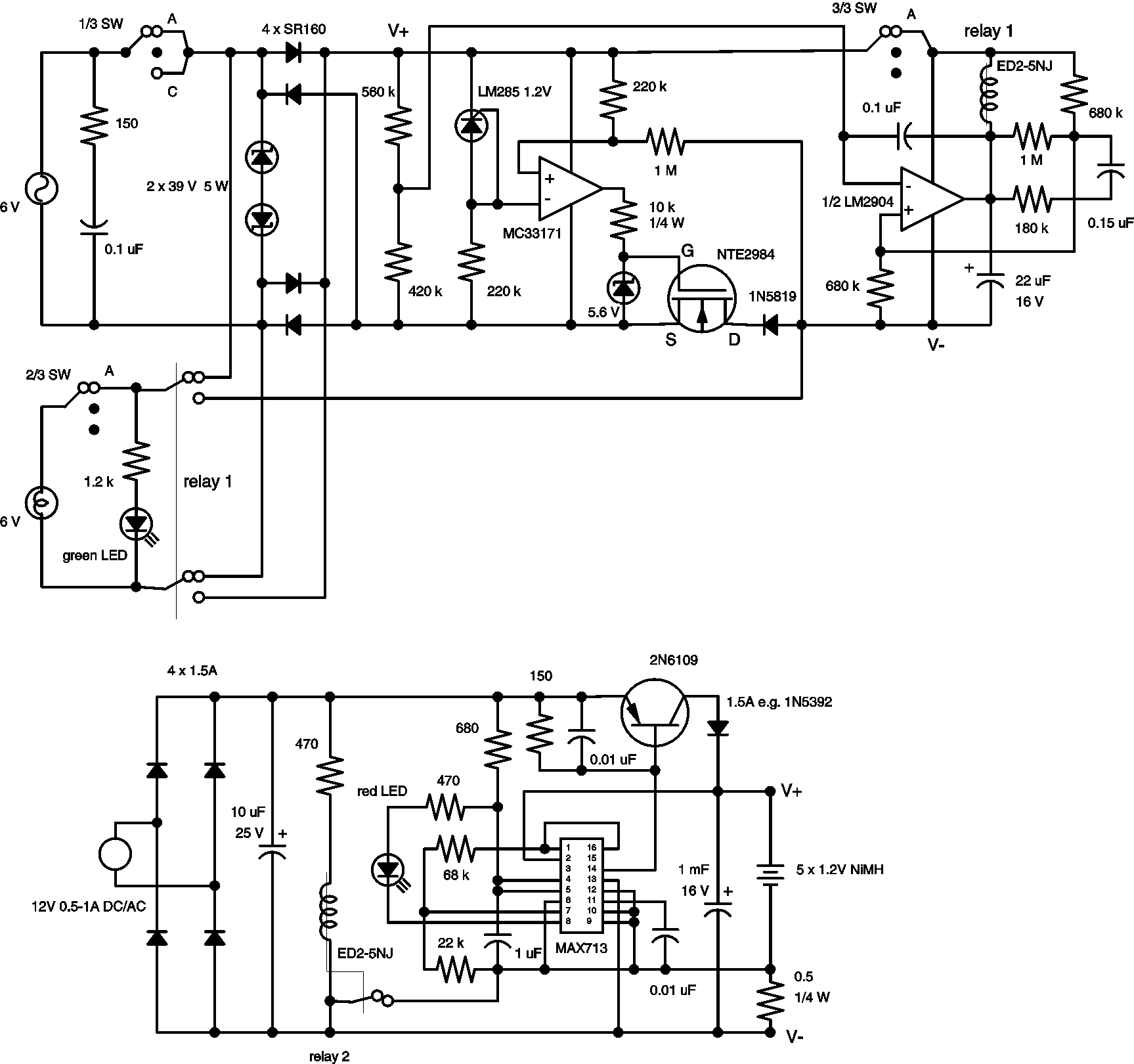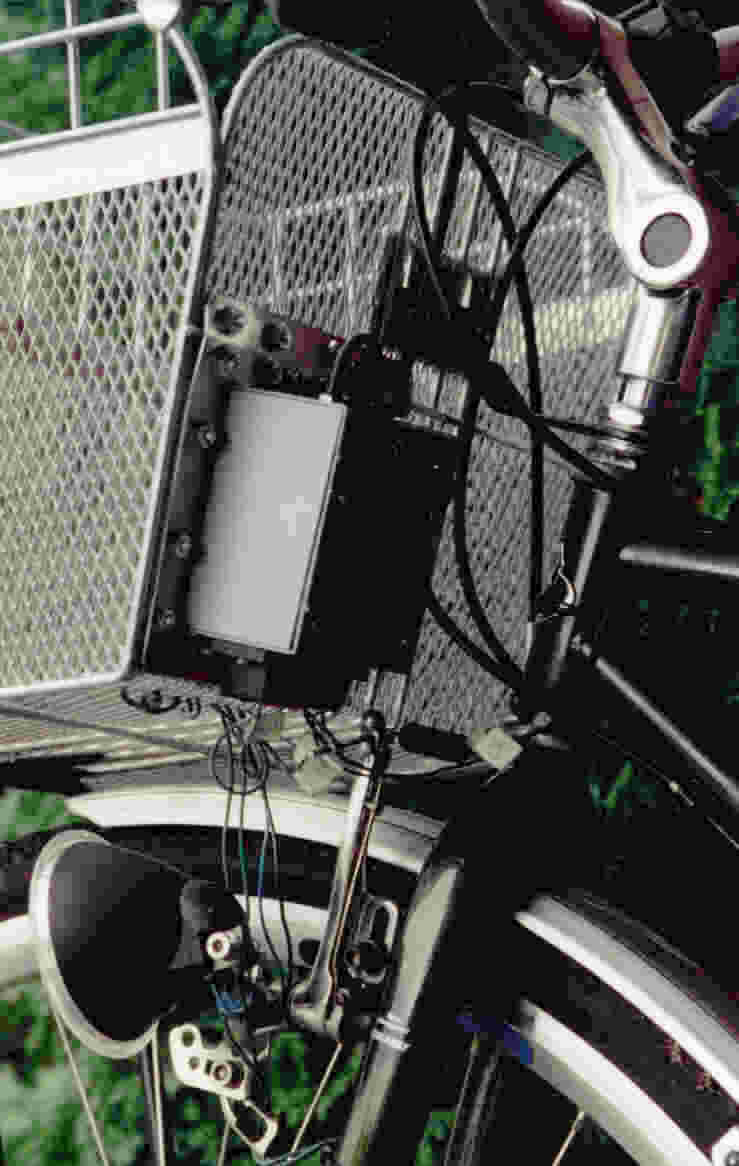Regulator for a Hub Dynamo
| This is a regulator for a 6V/3W bicycle hub generator system. The purpose is to manage the powering of bicycle lights from the hub generator and from rechargeable batteries, to charge the batteries using excess power from the generator, and to provide intelligent charging of the batteries from an AC adapter, when needed. |
| For a blown up view of the schematic click here. |

|
Principle
|
The switch has three positions: charge-off-light. In the
charge
position, the bicycle dynamo charges five AA NiMH batteries if
those are drained. If the batteries are reasonably
full, then the circuit draws virtually no power.
In the light position,
if the dynamo's average voltage is below some threshold
value, then the
bicycle lamps are fed by the batteries
aided by the rectified
dynamo
If the dynamo voltage is high, the lamps are fed
directly by AC from the dynamo and the dynamo excess power
is used to recharge batteries. The direct use of AC maximizes
efficiency. Additional circuitry is
provided for an intelligent charging of the batteries from an
outlet using a 12V AC or DC adapter. Practice shows that that
additional circuitry may be redundant.
A flickering green LED indicates the activity of the dynamo in
the charge mode and the fact that the light is fed by AC in the
charge mode.
A red LED indicates the fast charge state when the charging is
done from an outlet.
|
Circuit Board
Box
Complexity vs Efficiency
Regulator on the Bike

|
I have not invented any universal way of mounting the regulator
on the bike. In my situation, the most convenient placement
was on the outside of the front wire basket. Presumably, my
next choice would be a front rack or the fork.
The bike is Trek 730. My dynamo is a Schmidt, the older model that is not user serviceable. The front lamp is Bisy and the rear is DToplight (without a built-in standlight). Bisy is an excellent lamp. In my tests I found it two notches above Lumotec Halogen, with one notch separating Lumotec and Sigma. The philosophy which I follow is to have wiring that is serviceable by hands. 
|
Experiences
|
The regulator and a hub dynamo make a formidable combination.
My previous spoke dynamo and electric regulator combination was
good but not as outstanding as this one. The light delivery is
uninterrupted. When the bike slows down, the light just dims
a little before switching to the batteries. I often find
myself checking the green LED in order to figure out what
the main power source at a given moment is. Usually it is the
dynamo that powers the light but, aside from of course slowing
down to stop, the batteries often take over when riding uphill,
in heavy snow,
or in a heavy wind with rain.
Following the initial phase, after I removed the circuit protection, I had no problems of any kind with water. Many times already the bike stood for a full day in the rain and the circuit operated normally afterwards. Moreover, hosing the bike does not affect the circuit operation. The setup was mounted on the bike in May '00 and worked formidably throughout the serious winter. So far I had no real need to charge the batteries from the wall. (I did that on a couple of occasions just making sure that everything works.) Riding in the daylight one way of my commute seemingly suffices to keep the batteries full. The neutral position of the switch practically got no use either. After the above circuit, I designed a new one without a relay. In that circuit, the managing of power delivered to the lights from the dynamo and battery is done seamlessly using semiconductors, as is the delivery of power to the battery. At the same time, large electric currents encounter no single n-p semiconductor junction on their way, that would lead to losses. Zener diodes for limiting the power from the dynamo at high speeds are eliminated. A PCB version of that circuit just got over bench testing and now will get tested on a bike. |
Acknowledgments
| Being a complete amateur in the circuit design, without a clue what an operational amplifier was at the start or let alone a MOSFET, I benefitted a lot from designs made public by other people and in particular by Willie Hunt, Joe Gorin, and Steve Bush. The two last designs and several more were posted on the Net by Alex Wetmore who does much service to the cycling community by maintaining several lists at his site. I gained much information from the bikecurrent list (presently at Topica). Frequently asked questions for the bikecurrent list are maintained, in the true sense of the word, by William Burrow. Most direct help I received from Steve Kurt who faxed me his own schematic for a regulator and generously gave various type of advice. For my Bisy lamp I am grateful to Andreas Oehler. |